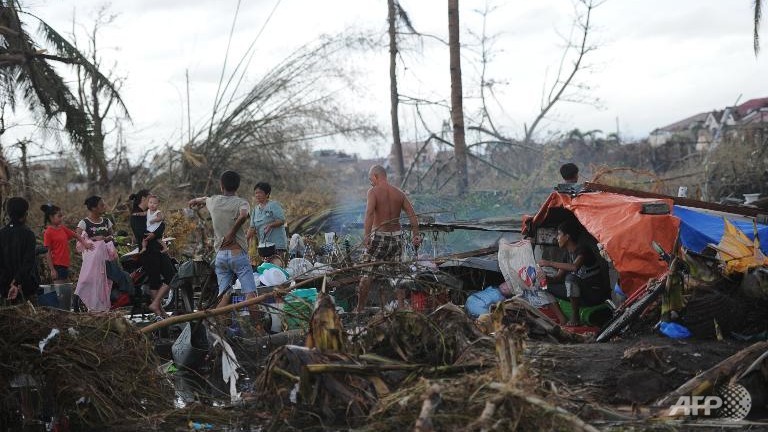Super typhoon intensifies as it tracks towards Philippines

A family stands amidst the debris in Tacloban city after Super Typhoon Haiyan swept over the Philippines.
(File photo: AFP/Ted Aljibe)
MANILA: A super typhoon gained strength on Thursday (Dec 4) as it tracked towards the Philippines, threatening more devastation for mostly poor communities where thousands of people have died in an annual tirade of mega-storms.
Weather forecasters warned Hagupit, already generating wind gusts of 240km an hour, would continue to intensify as it swept in from the Pacific Ocean, and likely hit eastern islands on Saturday. "Let's prepare for everything," President Benigno Aquino told a nationally televised meeting of disaster agency chiefs, after hearing warnings of giant storm surges and house-destroying winds.
Authorities said Hagupit would likely hit or pass near areas yet to recover from Super Typhoon Haiyan, the most powerful storm ever recorded on land that killed or left missing more than 7,350 people in November last year. In Tacloban, one of the cities worst-hit by Haiyan, some residents began evacuating from vulnerable coastal areas well ahead of Hagupit's expected arrival, while others emptied supermarket shelves of essential supplies.
"I survived Haiyan. I hope God will save me from Hagupit as well," 94-year-old grandmother Florentina Azcarga told AFP as her extended family of eight moved into a sports stadium in Tacloban. Azcarga and her family left their home with a pot of rice and bags of clothes to join hundreds of others in the stadium who had evacuated ahead of official orders.
With Hagupit still 700km from the Philippines, weather forecasters were not able to say exactly where the storm would hit and the government was yet to issue mandatory evacuation directives. But the storm has an enormous radius of 700km, meaning many millions of people are likely to be subjected to severe winds and intense rain. Schools were closed and ships ordered to stay in port across the eastern Philippines on Thursday.
MONSTER WINDS
The US Navy's Joint Typhoon Warning Center said Hagupit would generate sustained winds of 305km an hour and gusts of 370km an hour about the time it was expected to make landfall. This would make it nearly as powerful as Haiyan, which had sustained winds of 315km an hour when it crashed into the Philippines.
Philippine weather forecaster Pagasa predicted lower winds, but still warned of potential devastation. Some islands in the central Philippines would likely be hit by storm surges at least one storey high, according to Pagasa.
During Haiyan, unexpected storm surges more than two-storeys high swept kilometres inland in some places, destroying schools and other buildings that were being used as evacuation centres. The Philippines endures an average of 20 major storms a year, many of them deadly.
But the Southeast Asian nation, with a population of 100 million, has in recent years faced unusually strong storms that scientists have warned are linked to climate change.
More than 1,900 people were left dead or missing in December 2012 after Typhoon Bopha hit the southern Philippine island of Mindanao, an area that does not normally experience major storms. In December 2011, 1,268 people were killed when Tropical Storm Washi caused massive flooding in another part of Mindanao. Haiyan, Bopha and Washi were the world's deadliest storms of the past three years.
What the stars mean:
★ Poor ★ ★ Promising ★★★ Good ★★★★ Very good ★★★★★ Exceptional
Latest News
More News
- 72 nations sign landmark Hanoi cybercrime convention (October 26, 2025 | 18:00)
- UN Secretary-General commends Vietnam’s global leadership (October 26, 2025 | 09:00)
- APEC finance ministers convene to tackle regional challenges (October 22, 2025 | 17:31)
- Rewiring global trade: ASEAN’s rise as supply chain hub (October 17, 2025 | 11:40)
- Vietnam attends first World Nuclear Week Forum in Russia (September 26, 2025 | 10:50)
- Vietnam attends 69th session of IAEA General Conference (September 16, 2025 | 10:00)
- ADB, WB pledge over 12 billion USD for ASEAN power grid, renewable energy projects (August 15, 2025 | 14:18)
- Lowy Institute proposes AI-based tobacco control solutions for ASEAN (August 15, 2025 | 14:14)
- Cloud computing policy to position Malaysia as regional hub by 2030 (August 15, 2025 | 14:11)
- Thailand, Cambodia suffer numerous cyber attacks (August 05, 2025 | 16:19)


















 Mobile Version
Mobile Version